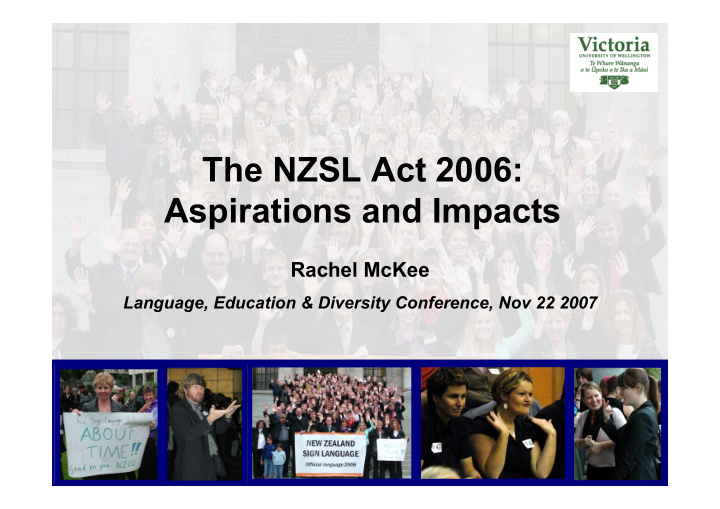



The NZSL Act 2006: Aspirations and Impacts Rachel McKee Language, Education & Diversity Conference, Nov 22 2007
Why is language recognition needed? • NZSL proscribed 1880 -1980. Marginalisation. • Sign language is instrumentally & culturally vital to Deaf social participation
Expectations of NZSL recognition Deaf concerns: • Consultation with • Status & awareness Deaf community & 27 Govt agencies, + • Access rights 293 submissions on • Maintenance, development the NZSL Bill Identified community issues re. NZSL use & govt ability to implement rights
Hybrid basis of the NZSL Act 2006 Language rights (Group) Human rights NZSL Act 2006 (Individual) “This Bill will provide official recognition of NZSL as a unique NZ Disability rights language and will contribute to achieving the (Social equity) vision of the NZ disability strategy : a fully inclusive NZ society”. Explanatory Note (p.2)
Provisions of the NZSL Act 2006 Purpose of the Act is “to promote and maintain NZSL” 1. NZSL declared an official (indigenous) language 2. Right to use NZSL in legal proceedings; empowers the making of regulations for interpreter competency standards. 3. Principles to guide government departments in promotion and use of NZSL • Reporting & monitoring via NZ Disability Strategy • Review of operation of the Act after 3 years
Impacts of the Act Validates Deaf people as a language community, with a marginalized cultural identity Accords NZSL equal status with spoken languages Formalizes right to use NZSL in legal proceedings Moral imperative (& raised expectation) for language access rights in govt service sector
Limitations of the Act χ no structure or resources for promotion and maintenance of NZSL (cf. Maori Language Act - MLC functions & funding) χ no new rights to use NZSL in other domains, eg: education employment police health broadcasting
Examples of NZSL-related initiatives • ACC - consumer information in NZSL translation (DVD) • Workbridge – video remote interpreting for clients • Statistics NZ – developing policy on use of NZSL • Ministry of Education – NZSL curriculum for mainstream schools • Health & Disability Commissioner – NZSL clip on website: ‘Deaf face’
Types of planning adressed by NZSL Act SELECTION - the variety to be recognised and developed is chosen & given new status ? SECURING ACCEPTANCE - changing attitudes (steps to enhance prestige, awareness of language) CODIFICATION - linguistic features are documented, standardised, disseminated ELABORATION - resources committed to extending the language (ie, to be capable of dealing with new usages - new concepts and contexts)
Consultations around NZSL Act & my research indicate that: • Lack of access to education in and through NZSL remains a sigificant barrier for Deaf people of all ages . • In schools : teachers & anciliiary staff lack NZSL skills; ‘hearing’ learning environments; lack of interpreters, notetakers, Deaf/NZSL role-models • Families of Deaf children feel unable to make fully informed choices about language; inadequate support to learn NZSL
Impact of language status on Deaf aspirations & achievement Sonia Pivac • 2nd generation Deaf - native signer • Fulbright award 2004 - to Gallaudet University, USA
From recognition to rights The moral basis of (minority language rights claims) is not, in itself, sufficient for the successful implementation of language rights …Thus, the advocates of language rights need to extend their arguments beyond the social justice and equity considerations that underpin language rights’ claims …in order to emphasise the practical advantages of implementing such rights within nation-states… Longstanding patterns of social, economic and educational disadvantage for minority language speakers can be addressed…” (May 2005:326)
Implementing the NZSL Act requires: • A STRATEGY : coordinated planning to promote NZSL rights (cf. Maori Language Strategy 2003) • Consultation on priorities – Aligning ‘top-down’ (state) & ‘bottom-up’ (community) efforts – Balancing Deaf community development v public awareness • Resources $$ - eg. supporting transmission of NZSL across generations, investing in interpreting services
Recommend
More recommend